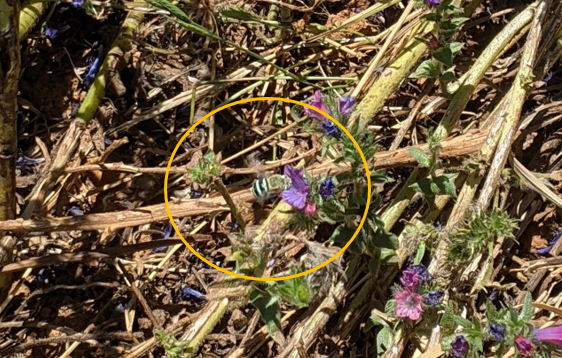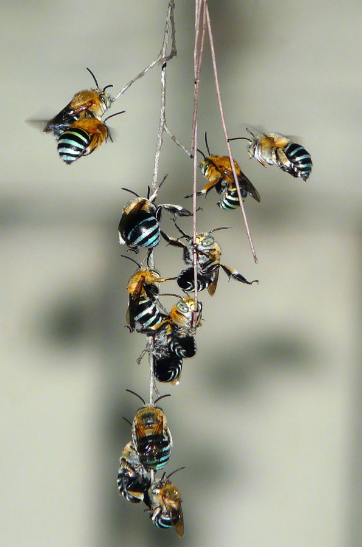Blue-Banded Bees
Our field scientists were lucky enough to find blue bees buzzing around a couple sites recently, so we thought it would be a great opportunity to share some information about these lesser-known native Australian species.
Blue-banded bees (Amegilla species) were spotted at locations in Lancelin and Byford, two very different sites geographically and geologically. The most common species of blue-banded bees (A. chlorocyanea) typically make nests in shallow sandy soils, while other related species can make burrows in harder, clayey soils or mud-brick walls.
The flight of blue-banded bees is characterized by hovering and darting, making it difficult for our fieldies to get a photo, but we were lucky enough to grab a quick snap while one was landing. These bees typically only fly and breed during the summer months, making them hard to spot for most of the year.

Female blue-banded bees are typically solitary, building solitary burrows after mating to deposit eggs. Some females often build their separate nests in the same location, although we didn’t find any near our sampling sites. Males often “roost” together, clinging to twigs with their mandibles in groups.

These bees can not only look spectacular, but they also play an important role in pollinating quite a few of our native Australian flowers, and crop plants such as tomatoes. These bees perform a particular type of pollination called “buzz pollination”, also known as sonication.
The stamen of a flower is the pollen-producing reproductive organ of a flower. Attached to the stamen is the anther, which holds the pollen. In some plants, the anther holds onto the pollen so tightly that the pollen can only be released by shaking the anther. The blue-banded bees are capable of grabbing onto a flower and rapidly vibrating their bodies which dislodges the pollen to be collected by the bee. The bee can then spread the pollen to other plants for reproduction. The common European Honeybee is incapable of performing this type of pollination, making blue-banded bees extremely valuable to Australian farmers and native flora.
Tomato plants are a great example of this type of flower-bee symbiosis, with farmers often using vibrating wands to artificially pollinate the tomato plants in absence of buzz-pollinators! The European Bumblebee is also capable of pollinating in this way on overseas farms, however introducing this species of bee to Australia could be harmful to our environment. Introduced bee species can spread weeds on farms, compete with native bees and birds, spread pathogens or parasites, and reduce native wildflower populations.
Blue-banded bees could fill the pollination gap, with some research suggesting tomato plants produce more tomatoes that were also heavier and contained less seeds when pollinated via buzz-pollination. Maybe one day we will see more blue-banded bees working with Aussie farmers for crop production, and more of these bees buzzing about on our native flora!
